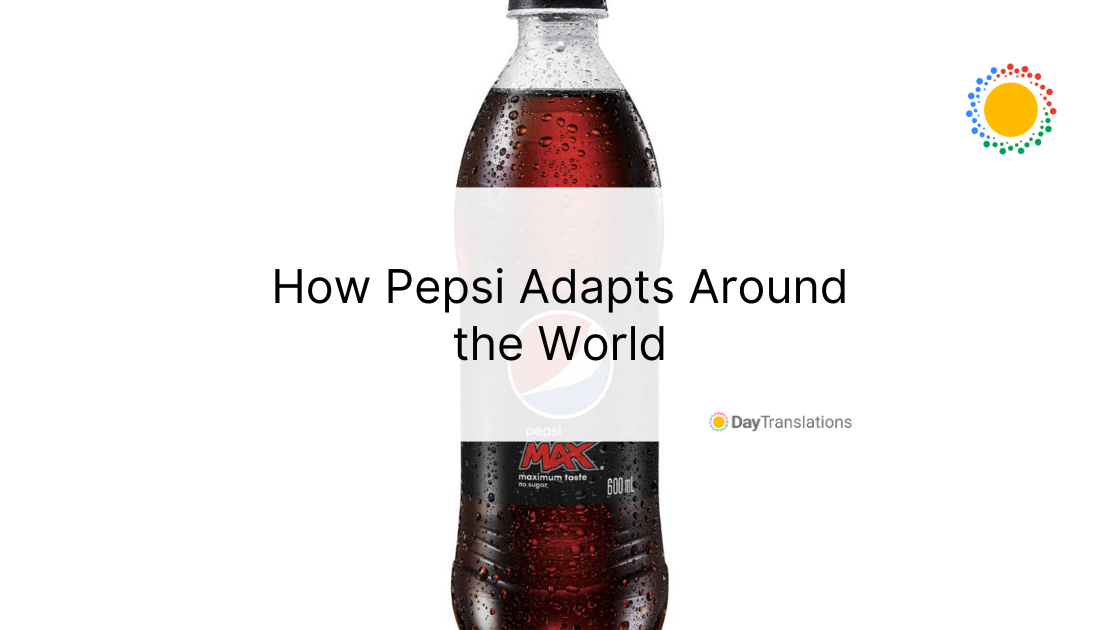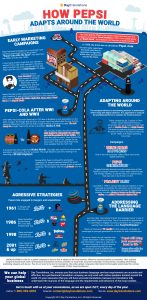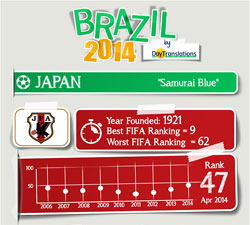Pepsi is one of the most popular carbonated beverages in the world. It’s the main competitor of Coca-Cola, another carbonated beverage from the United States, which was introduced in 1886, 133 years ago. If you calculate Pepsi’s existence since it was first created in 1893, Pepsi has been in the market for 126 years.
Pepsi’s History
Like many popular drinks in the market today, Pepsi was born in a drugstore, invented by a chemist. In the case of Pepsi, Caleb Bradham was its creator. When he introduced the drink in 1893, it was called simply as “Brad’s Drink.” Its birthplace was New Bern in North Carolina.
The drink was re-christened Pepsi-Cola in 1898. The new name came from the Greek word that is equivalent to digestion, which when pronounced sounds like Pepsi. It was a fitting name since the Pepsi part was supposed to mean ”to aid” while the cola part was from one of the ingredients, the kola nut, an African fruit that contains caffeine.
Bradham’s intention when he created the drink was to offer something that would boost the energy of drinkers and at the same time help in digestion. The bottling of Pepsi-Cola was moved from Bradham’s drugstore to a warehouse in 1903 as sales increased.
Indeed, Pepsi-Cola was sold and advertised as an aid for digestion, using “Exhilarating, Invigorating, Aids Digestion” as its slogan. It switched strategy as sales improved further. By 1909, it had its first celebrity endorser, Barney Oldfield, an American automobile racecar driver. Pepsi-Cola’s new slogan, “Drink Pepsi-Cola. It Will Satisfy You” helped popularize Oldfield.
In 1961, the soft drink’s name was shortened to just Pepsi. The product’s association with celebrity endorsers continues to this day.
Early Marketing Campaigns
Pepsi had several slogans as it convinced more and more consumers to buy the product. “Pepsi-Cola Hits the Spot” was used from the 1930s until the late 1950s. It also had a product jingle that was utilized in various forms, with some changes in the lyrics. Radio
commercials were very popular then and Pepsi used the voice of Patty Bergen in its jingle.
American actress Joan Crawford, who was then married to Alfred N. Steele, the president of Pepsi-Cola, was its spokesperson. She was also the product’s endorser and advertising model.
Since the early days, Pepsi has had associations with celebrities and continued this tradition for many years. Pepsi-Cola had product placements in some of the movies of Joan Crawford. It was prominently featured in other Hollywood films, such as Back to the Future, Fight Club, Home Alone, World War Z and Wayne’s World.
Pepsi-Cola After WWI and WWII
After WWI, Pepsi-Cola went bankrupt in 1923 due to Bradham’s over speculation on the price of sugar. He thought that the price of sugar would overshoot after the war, but the opposite happened, which left him with a huge inventory of expensive sugar. The Loft Candy Co. bought Pepsi-Cola, led by its president, Charles G. Guth. The company struggled through the Great Depression and it was even offered to rival Coca-Cola.
The company made a turnaround when Guth decided to reformulate the soft drink and sold the product in 12 oz. bottles. The price was just five cents. Coca-Cola at that time was selling in 6 oz. bottles for the same price. The move made Pepsi-Cola more saleable than its main rival. It produced the radio jingle titled Nickel Nickle. The jingle was used for its countrywide promotion, which was a first for a product. The jingle became such a hit, leading to its recording in 55 other languages.
During WWII, Pepsi continued its production, supplying U.S. troops stationed around the world. After the war, the brand was already known in several countries. The company was led by Al Steele after the war.
Aggressive Strategies
Al Steele used to be the vice-president of Coca-Cola. He placed great emphasis on huge sales promotions and advertising campaigns, which resulted in increased sales. The massive campaigns increased the brand’s net revenue 11 times around the 1950s.
Afterwards, Pepsi-Cola engaged in mergers and acquisitions. It merged with the manufacturer of Doritos, Fritos, Rold Gold pretzels and Lay’s potato chips – Frito-Lay, Inc. Pepsi diversified further by purchasing Kentucky Fried Chicken, Taco Bell and Pizza Hut. It also purchased Seven-Up International and later added up Dole and Tropicana
juice brands. Pepsi merged with Quaker Oats in 2001. Through the years, it also added Mountain Dew, Gatorade sports drink and Lipton Tea to its group.
Pepsi Adapts Around the World
Pepsi positioned its brand and products as beverages and snacks with several choices, offering healthier products from its many acquisitions. Pepsi wanted to be a brand that reverberates youthful energy, which is reflected in its marketing and advertising campaigns. It ensures that its many products are readily available and affordable, which is appealing to different income segments. Its release of smaller options of its soft drinks brand worldwide makes it very accessible and affordable particularly to the youth and teenagers who lead a fast moving and modern lifestyle.
Aside from its pricing schemes, Pepsi invests heavily in packaging and product innovation. It continues to provide healthier and more nutritious options from its other products and made changes to its packaging to retain existing customers and attract new ones.
The company believes in maintaining presence in mainstream media along with digital channels. It is aggressive in using all the available platforms to maintain its market presence. One of the more popular videos Pepsi runs in the digital platforms is Bring Home Happiness.
Through the years, Pepsi made several remarkable campaigns, such as the Pepsi Generation that targeted the baby boomers and the introduction of Diet Pepsi for younger consumers.
It also made several forays into foreign markets. It was the first U.S. made product that was sold in the former U.S.S.R., when Pepsi was produced and sold in the country in 1974.
Project Blue, another marketing strategy of Pepsi, was launched in 1996 in various international markets. It was a campaign to celebrate the company’s centennial year. Several publicity stunts were launched to support the strategy. It had a banner placed on the Mir space station and painted a Concorde airplane blue, aside from other activities. It marked the launch of the Pepsi Globe logo as well.
Branding is very important and an aggressive and youthful company like Pepsi is an innovator. It announced in 2008 that it would be making changes in its logo again. By 2009, Pepsi, Pepsi Max and Diet Pepsi started using lower case fonts for its Pepsi Globe logo, simulating ”smiles” with the angle of the white band changing according to the product.
From 2009 until 2010, the redesigned logo was released in Pepsi’s markets, first in Canada, then to South American markets, Australia, the Philippines and the rest of the world.
Pepsi was using niche marketing as early as the 1940s. At that time, the company president was Walter Mack. He realized that the Black Americans, who used to be called the Negro market, were being ignored by the predominantly white-owned corporations. He thought that it was an untapped market and formed a team to advertise to the black population exclusively. His efforts were hampered by WWII but he continued postwar, appointing Edward F. Boyd to head a 12-man advertising team. They created a campaign showing black people in a positive light. One ad featured Ron Brown as a young boy. He later became the U.S. Secretary of Commerce. Another ad, ”Leaders in Their Fields,” featured 20 African Americans who were leaders in their field, such as Gordon Parks and Ralph Bunche.
The move to embrace diversity increased the sales of Pepsi in the black community by the 1950s, with Pepsi outselling Coca-Cola.
Utilizing All channels
Pepsi is not one to pass up an opportunity to make its presence felt. It continues its association with films and music, sponsoring and producing concerts and special events where the brand can be closer to the public. It entered the world of sports via sponsorships of major teams and sporting events and teams, such as the UEFA champions’ league, National Basketball Association (including USA Basketball, NBA Development League and WNBA). In 2016, Pepsi started to be a partner of India’s Board of Control for Cricket.
The company and its products are everywhere in social media as well. The company maintains separate accounts for its different products on Facebook, which it utilizes for promotion and marketing activities. It shares its different promotional activities through Twitter, where the company also has separate accounts for its various products. Pepsi creates special videos to share on YouTube and shares tons of images on Instagram.
Providing Healthier Options
Nutritionists continually say that soft drinks are bad for people’s health due to their high sugar content. Pepsi answers that by providing several nutritious and healthier alternatives. The company introduced Aqua Minerale water and juice, more flavors for its Kevita Master Brew Kambocha brand and Tropicana Probiotics, among others. For the Latin American market, it launched a whole grain oats-based food item called Three Minutos. It introduced Sweet Potato Crisps, Hummus Crisps and Veggie Crisps for the
UK and U.S. markets. Many of its new products fall under different categories, namely, Better for You, Good for You and Fun for You. To cater for the different tastes of its foreign consumers, Pepsi invests in additional flavors and product reformulation.
Addressing the Language Barrier
Just like other international brands, the language barrier is one of the hurdles Pepsi has to face. One of its innovative approaches is to use emojis to engage its young consumers. It’s a campaign used by Pepsi worldwide, called #sayitwithpepsi. Pepsi commissioned 70 emojis for this particular campaign, to encourage its younger generation to use them for their conversations. The Pepsi emojis are printed on cups, bottles and cans of Pepsi.
Of course, Pepsi has not forgotten that proper translation of their campaigns and information materials is important to the brand, keeping in mind the lessons the company learned from the mistranslation woes it suffered when it tried to explore new markets such as China.
Work with Experts for Effective Business Communication Day Translations, Inc. ensures you that your business language services requirements are accurate and effective. As a professional translation company, we only work with native speakers located around the world. It’s your assurance that you will have accurate translations, because our translators fully understand the nuances of the language and the requirements and behaviors of the local markets. Let’s discuss your need for professional language services. Give us a call at 1-800-969-6853 or send us an email at [email protected] . You can reach us anytime, as we are open 24/7, 365 days of the year.













Sorry, the comment form is closed at this time.